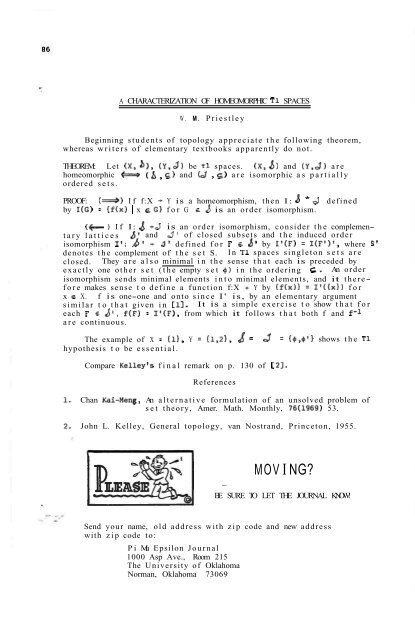You also want an ePaper? Increase the reach of your titles
YUMPU automatically turns print PDFs into web optimized ePapers that Google loves.
A CHARACTERIZATION OF HOMEOMORPHIC Tl SPACESW. M. PriestleyBeginning students of topology appreciate the following theorem,whereas writers of elementary textbooks apparently do not.THEOREM: Let (X,b), (Y,J) be tl spaces. (X,d) and (Y,J) arehomeomorphic (hordered sets., and (3 , G) are isomorphic as partiallyPROOF: (d) If f:X + Y is a homeomorphism, then I: * d definedby I(G) = (f(x) 1 x &GI for G e. ç is an order isomorphism.(6 ) If I: a *J is an order isomorphism, consider the complementarylattices and J' of closed subsets and the induced orderisomorphism 1': % * a)' defined for F e. J' by I1(F) = I(F1)', where S'denotes the complement of the set S. In Tl spaces singleton sets areclosed. They are also minimal in the sense that each is preceded byexactly one other set (the empty set 1(1) in the ordering C. An orderisomorphism sends minimal elements into minimal elements, and it thereforemakes sense to define a function f:X + Y by (f(x)} = I1((x}) forx e X. f is one-one and onto since I' is, by an elementary argumentsimilar to that given in [l]. It is a simple exercise to show that foreach F â j', f(F) = It(F), from which it follows that both f and f-1are continuous.PROBLEM DEPARTMENTEdited byLeon Bankoff, Los Angeles, CaliforniaThis department welcomes problems believed to be new and, asa rule, demanding no greater ability in problem solving than that ofthe average member of the Fraternity, but occasionally we shall publishproblems that should challenge the ability of the advanced undergraduateor candidate for the Master's Degree. Solutions should be submittedon separate, signed sheets and mailed before August 1, 1970Address all communications concerning problems to Leon Bankoff,6360 Wilshire Boulevard, Los Angeles, California 90048.PROBLEMS FOR SOLUTION232. Proposed by Solomon W. Golomb, University of So. Calif., LosAngeles .Find a direct combinatorial interpretation of this identity:The example of X = (l}, Y = (1,2), = a! = (1(1,1(1'} shows the Tlhypothesis to be essential.Compare Kelley's final remark on p. 130 of [2].ReferencesChan Kai-Meng, An alternative formulation of an unsolved problem ofset theory, Amer. Math. Monthly, 76(1969) 53.John L. Kelley, General topology, van <strong>No</strong>strand, Princeton, 1955.MOV I NG?-BE SURE TO LET THE JOURNAL KNOW!Send your name, old address with zip code and new addresswith zip code to:<strong>Pi</strong> <strong>Mu</strong> <strong>Epsilon</strong> Journal1000 Asp Ave., Room 215The University of Oklahoma<strong>No</strong>rman, Oklahoma 73069233. Proposed by Charles W. Trigg, San Diego, California.The director of a variety show wanted to give the female impersonatora job, but questioned his ability to dance with thehigh-kicking Folies Bergere chorus. In reply to the director'sguery, the impersonator's Spanish agent said:"SI/HE = .CAN CANCAN...,but .CAN be less than one-fourth effective in his demonstrationtoday ."If each letter of the cryptarithm uniquely represents a digitin the scale of eleven, what is the sole solution?234. Proposed by Charles W. Trigg, San Diego, California.Show that when the nine positive digits are 2 8 7distributed in a square array so that no column, 6 1 4row, or unbroken diagonal has its digits in order 5 3 9of magnitude, the central digit must always be odd.235. Proposed by James E. Desmond, Florida State University.Prove that an+l divides (ab + c) (ad)n - ctad)" for integersa > 0, b, c, d > 0 and n > 0.
















